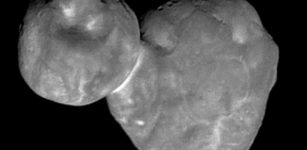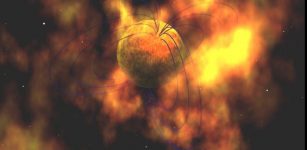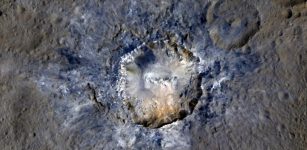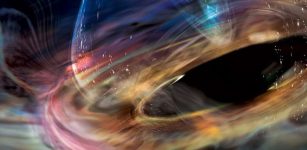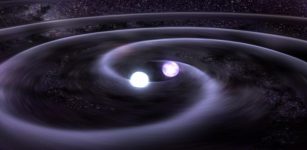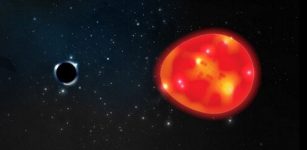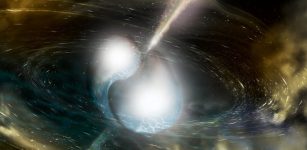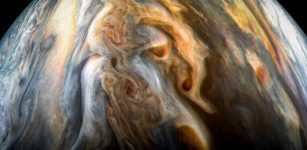‘String of Pearls’ And Supernova 1987A – One Of The Brightest Exploding Stars In More Than 400 Years
Eddie Gonzales Jr. – MessageToEagle.com – Physicists frequently rely on the Rayleigh-Taylor instability to justify the formation of fluid structures in plasmas but this theory might not completely account for the phenomenon observed in supernova 1987A’s hydrogen clump ring.
The simulation shows the shape of the gas cloud on the left and the vortices, or regions of rapidly rotating flow, on the right. Each ring represents a later time in the evolution of the cloud. It shows how a gas cloud that starts as an even ring with no rotation becomes a lumpy ring as the vortices develop. Eventually the gas breaks up into distinct clumps. Credit: Michael Wadas, Scientific Computing and Flow Laboratory, University of Michigan
The Crow instability provides a more comprehensive explanation for the “string of pearls” phenomenon surrounding the remnants of a star. This insight potentially illuminates an enduring enigma in astrophysics, researchers say in a new study.
“The fascinating part about this is that the same mechanism that breaks up airplane wakes could be in play here,” Michael Wadas, corresponding author of the study and a graduate student in mechanical engineering at the time of the work, said in a press release.
In jet contrails, a mechanism known as the Crow instability is responsible for causing disruptions in the otherwise smooth cloud line. This occurs due to the spiraling airflow that emanates from each wing’s end, referred to as wingtip vortices. These vortices intertwine with each other, subsequently leading to the creation of gaps. Notably, the Crow instability possesses a capability that Rayleigh-Taylor does not: it can forecast the number of clumps observed around remnants.
“The Rayleigh-Taylor instability could tell you that there might be clumps, but it would be very difficult to pull a number out of it,” said Wadas, who is now a postdoctoral scholar at the California Institute of Technology.
Supernova 1987A is one of the most prominent stellar explosion mainly because it is not so far from Earth – only 163,000 light years away, and the light from this celestial event reached our planet during an era when advanced observatories were available to observe its development.
This is the first supernova that could be seen without the aid of a telescope since Kepler’s Supernova in 1604, marking it as an extraordinarily uncommon astrophysical occurrence.
A near-infrared image of the remnant left behind by supernova 1987A, taken by the James Webb Space Telescope. The hydrogen clumps known as the “string of pearls” appear as a ring of white dots around the teal center of the stellar remnant, still shining brightly due to the energy imparted by the supernova shockwave. The number of clumps is consistent with the Crow instability having caused them to form. Credit: NASA, ESA, CSA, M. Matsuura (Cardiff University), R. Arendt (NASA’s Goddard Spaceflight Center & University of Maryland, Baltimore County), C. Fransson (Stockholm University), J. Larsson (KTH Royal Institute of Technology), A. Pagan (STScI)
Much about supernova 1987A is still unknown but astronomers believe that the ring of gas surrounding the star ahead of the explosion came from the merger of two stars.
As these celestial bodies transitioned into blue giants several millennia prior to the supernova, they released hydrogen into the surrounding space. This resulted in a ring-shaped gas cloud, which was subsequently influenced by the high-velocity charged particles emanating from the blue giant, a phenomenon referred to as stellar wind.
It is hypothesized that these clumps were formed before the star underwent its explosive transformation.
The researchers simulated the way the wind pushed the cloud outward while also dragging on the surface, with the top and bottom of the cloud being pushed out faster than the middle. This caused the cloud to curl in on itself, which triggered the Crow instability and caused it to break apart into fairly even clumps that became the string of pearls. The prediction of 32 is very close to the observed 30 to 40 clumps around the supernova 1987A remnant.
“That’s a big piece of why we think this is the Crow instability,” said Eric Johnsen, U-M professor of mechanical engineering and senior author of the study.
The team saw hints that the Crow instability might predict the formation of more beaded rings around the star, further out from the ring that appears brightest in telescope images. They were pleased to see that more clumps seem to appear in the shot from the James Webb Space Telescope’s near-infrared camera, released in August last year, Wadas explained.
The team also suggested that the Crow instability might be at play when the dust around a star settles into planets, although further research is needed to explore this possibility.
Study is published in Physical Review Letters.
Written by Eddie Gonzales Jr. – MessageToEagle.com Staff Writer




